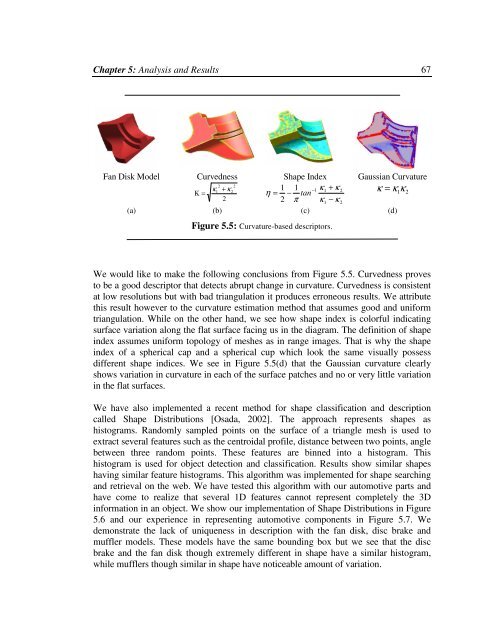To the Graduate Council: I am submitting herewith a thesis written by ...
To the Graduate Council: I am submitting herewith a thesis written by ...
To the Graduate Council: I am submitting herewith a thesis written by ...
Create successful ePaper yourself
Turn your PDF publications into a flip-book with our unique Google optimized e-Paper software.
Chapter 5: Analysis and Results 67Fan Disk Model CurvednessShape Index Gaussian Curvature2 2κ1+ κ1 12−1κ1+ κ2 κ = κΚ =η = − tan1κ 222 π κ1− κ2(a) (b) (c) (d)Figure 5.5: Curvature-based descriptors.We would like to make <strong>the</strong> following conclusions from Figure 5.5. Curvedness provesto be a good descriptor that detects abrupt change in curvature. Curvedness is consistentat low resolutions but with bad triangulation it produces erroneous results. We attributethis result however to <strong>the</strong> curvature estimation method that assumes good and uniformtriangulation. While on <strong>the</strong> o<strong>the</strong>r hand, we see how shape index is colorful indicatingsurface variation along <strong>the</strong> flat surface facing us in <strong>the</strong> diagr<strong>am</strong>. The definition of shapeindex assumes uniform topology of meshes as in range images. That is why <strong>the</strong> shapeindex of a spherical cap and a spherical cup which look <strong>the</strong> s<strong>am</strong>e visually possessdifferent shape indices. We see in Figure 5.5(d) that <strong>the</strong> Gaussian curvature clearlyshows variation in curvature in each of <strong>the</strong> surface patches and no or very little variationin <strong>the</strong> flat surfaces.We have also implemented a recent method for shape classification and descriptioncalled Shape Distributions [Osada, 2002]. The approach represents shapes ashistogr<strong>am</strong>s. Randomly s<strong>am</strong>pled points on <strong>the</strong> surface of a triangle mesh is used toextract several features such as <strong>the</strong> centroidal profile, distance between two points, anglebetween three random points. These features are binned into a histogr<strong>am</strong>. Thishistogr<strong>am</strong> is used for object detection and classification. Results show similar shapeshaving similar feature histogr<strong>am</strong>s. This algorithm was implemented for shape searchingand retrieval on <strong>the</strong> web. We have tested this algorithm with our automotive parts andhave come to realize that several 1D features cannot represent completely <strong>the</strong> 3Dinformation in an object. We show our implementation of Shape Distributions in Figure5.6 and our experience in representing automotive components in Figure 5.7. Wedemonstrate <strong>the</strong> lack of uniqueness in description with <strong>the</strong> fan disk, disc brake andmuffler models. These models have <strong>the</strong> s<strong>am</strong>e bounding box but we see that <strong>the</strong> discbrake and <strong>the</strong> fan disk though extremely different in shape have a similar histogr<strong>am</strong>,while mufflers though similar in shape have noticeable <strong>am</strong>ount of variation.
















